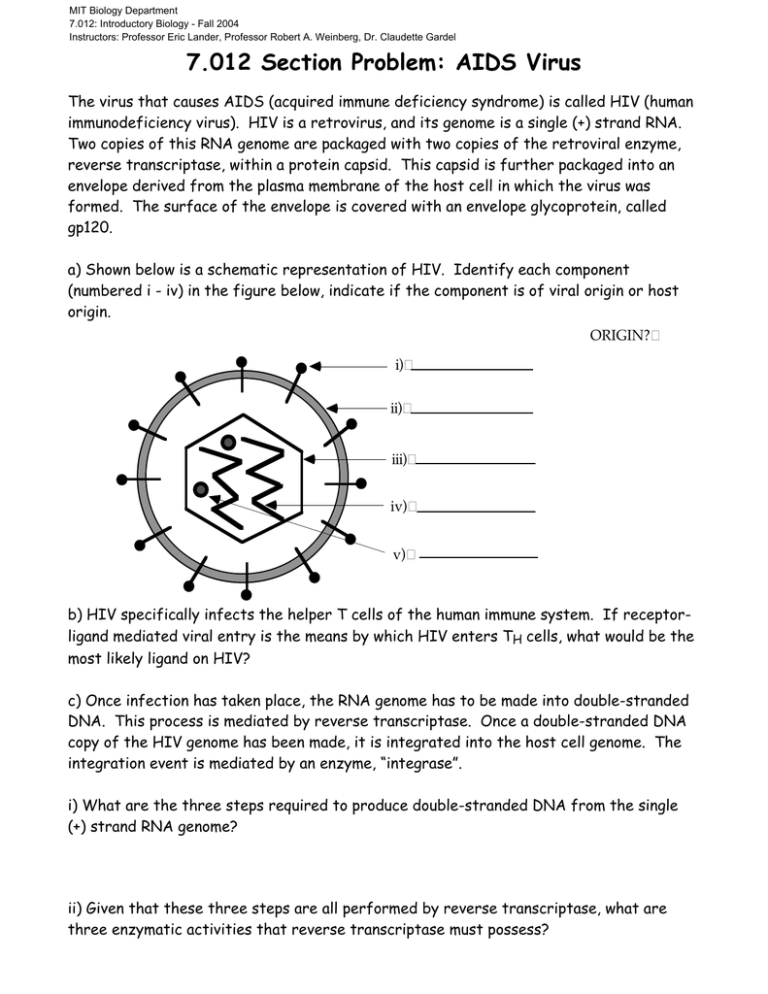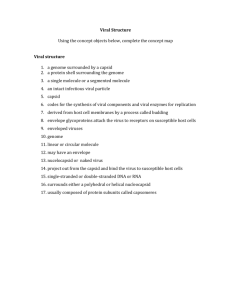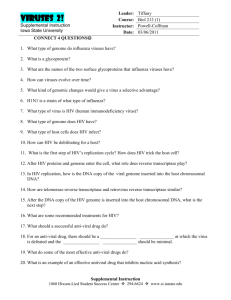Document 13478151
advertisement

MIT Biology Department 7.012: Introductory Biology - Fall 2004 Instructors: Professor Eric Lander, Professor Robert A. Weinberg, Dr. Claudette Gardel 7.012 Section Problem: AIDS Virus The virus that causes AIDS (acquired immune deficiency syndrome) is called HIV (human immunodeficiency virus). HIV is a retrovirus, and its genome is a single (+) strand RNA. Two copies of this RNA genome are packaged with two copies of the retroviral enzyme, reverse transcriptase, within a protein capsid. This capsid is further packaged into an envelope derived from the plasma membrane of the host cell in which the virus was formed. The surface of the envelope is covered with an envelope glycoprotein, called gp120. a) Shown below is a schematic representation of HIV. Identify each component (numbered i - iv) in the figure below, indicate if the component is of viral origin or host origin. ORIGIN? i) ii) iii) iv) v) b) HIV specifically infects the helper T cells of the human immune system. If receptorligand mediated viral entry is the means by which HIV enters TH cells, what would be the most likely ligand on HIV? c) Once infection has taken place, the RNA genome has to be made into double-stranded DNA. This process is mediated by reverse transcriptase. Once a double-stranded DNA copy of the HIV genome has been made, it is integrated into the host cell genome. The integration event is mediated by an enzyme, “integrase”. i) What are the three steps required to produce double-stranded DNA from the single (+) strand RNA genome? ii) Given that these three steps are all performed by reverse transcriptase, what are three enzymatic activities that reverse transcriptase must possess? In recent years, therapies have been developed to fight AIDS using nucleotide analogs. The drug most widely used to combat AIDS is Azidothymine (AZT). The structure of AZT is very similar to thymidine except that in AZT, the 3'-hydroxyl (OH) group on the deoxyribose ring has been replaced by an azido (N3) group. d) Which process of the life cycle of the HIV do you think is inhibited by AZT? e) What other phase in the HIV life cycle may be more appropriate to disrupt, one that won't likely affect host cellular processes? Explain your answer. AZT resistant forms of HIV have been isolated. These mutant viruses have mutations in one of the genes of the virus that result in resistance to AZT. f) In which viral gene do you think are the mutations most likely to be found? Explain. g) Starting with the virus in the bloodstream, order the following steps in the life cycle of HIV. A- Entry of the viral genome into the nucleus. B- Adsorption of the viral proteins to cell-surface receptors. C- Degradation of DNA-associated viral RNA. D- Fusion of the viral membrane with the plasma membrane. E- DNA-dependent RNA synthesis. F- Integration of the viral nucleic acid into the host genome. G- Encapsidation of the viral genome into protein coats.





